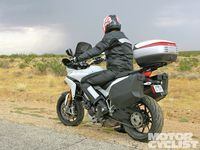Wrist: Tim Carrithers
Msrp (2010): $19,995
Miles: 9390
Mpg: 39
Mods: Shad SH50 top case, Michelin tires
It didn’t look like much from a distance. Just a little high-desert rainstorm. Enough to moisten El Mirage Dry Lake and cool things off toward the end of a long, hot, meandering ride home from Palm Springs. About 15 minutes later, however, that “little” storm was firing a 40-mph slurry of rain, sand and gravel across the road, along with visible lightning strikes and squadrons of low-flying tumbleweeds. As El Mirage Road looked more and more like a river, it seemed like the previously unsinkable Duc was about to drown. Things were under some sort of control for the moment, but a fair amount of the storm had already worked its way into my personal space. If it moistened the Ducati’s extensive electronic central nervous system, I was looking at a long swim home. No shelter in sight? Press onward and pray!
An hour-and-a-half later I rolled into the garage, mud-splattered and saturated, but otherwise unscathed thanks to God, Bosch, Brembo, Ducati and Michelin. Especially Michelin. The Multi plowed through windborne water, sand, gravel, unidentified flying flora and the axle-deep water without a hiccup. Michelin's new Pilot Road 3 radials ($215.95 front, $325.95 rear; _www.michelinmotorcycle.com_) refused to slip, generating more traction in the wet than any other tires I've tried. Enough for a celebratory second-gear wheelie once the worst was behind us. This pair showed no discernable wear after more than 2000 hard miles. The dual-compound 2CT design performed as advertised, providing plenty of cornering grip while preventing the squared-off center that comes with too many freeway miles. Bottom line? They're brilliant.
The Multi's vital systems had proven themselves 100 percent watertight, but I wasn't sure about my new Shad SH50 top case ($418 complete with passenger backrest and mounting kit; _www.shad.es/en/shad-usa/_). It went on easily enough prior to the deluge, the Spanish maker's 50-liter trunk swallowing up to 17.6 lbs. of cargo, including two full-face helmets. And thanks to a secure locking latch and a genuinely waterproof seal, a weekend's worth of kit came out the same way it went in: bone-dry. The whole thing clicks off in seconds when you're traveling light. The 48-liter Ducati Performance top case carries 22 lbs. of gear, costs around 50 percent more and is arguably less attractive. So? Pack 4.4 lbs. lighter, live with one less Ducati logo and spend the difference on a sporty-touring weekend out of town.
Go as long and hard as you like. I did, and if this bike is any indication, Ducati reliability is miles from the expensive oxymoron it once was. I’ve ridden from one end of California to the other without breaking anything more than a $4.60 shifter-pivot bolt and one burned-out taillight LED. I’ve changed tires and brake pads once, the engine oil and filter twice and oiled/adjusted the chain a half-dozen times. That’s it.
Looking into the chronically blurry rear-view mirrors with the benefit of 20/20 hindsight, I could’ve and probably would’ve made this trip without the Sport model’s Electronically Adjustable Everything. My right wrist usually does a decent job of matching throttle position with available grip. With the stiffer Öhlins shock spring in place and both ends dialed in, I can go from Sport to Touring mode and back without electronic assistance. I tried the engine’s nutted Enduro and Urban settings for maybe 10 miles. It’s been parked in full-power Sport mode ever since. Why pay for features you never use? Okay, even at $14,995 for the unadorned model, the Multistrada isn’t cheap. But aside from that one broken bolt, it’s been fast, agile, dependable, practical and comfortable enough to make me look forward to any ride, regardless of the destination. On top of all that, the Multistrada never let me or anybody else in the immediate vicinity forget that it’s a Ducati.














/cloudfront-us-east-1.images.arcpublishing.com/octane/VZZXJQ6U3FESFPZCBVXKFSUG4A.jpg)
/cloudfront-us-east-1.images.arcpublishing.com/octane/QCZEPHQAMRHZPLHTDJBIJVWL3M.jpg)
/cloudfront-us-east-1.images.arcpublishing.com/octane/HXOUJXQWA5HBHGRO3EMJIGFMVI.jpg)

/cloudfront-us-east-1.images.arcpublishing.com/octane/3TIWWRV4JBBOLDVGRYECVVTA7Y.jpg)
/cloudfront-us-east-1.images.arcpublishing.com/octane/KIX5O23D5NAIBGFXBN3327DKZU.jpg)
/cloudfront-us-east-1.images.arcpublishing.com/octane/7GJYDUIPXRGMTMQKN6ONYOLBOU.jpg)
/cloudfront-us-east-1.images.arcpublishing.com/octane/MUQLOVLL2ZDGFH25ILABNBXKTI.jpg)
/cloudfront-us-east-1.images.arcpublishing.com/octane/TNOU5DNE2BC57MFPMGN2EIDXAM.jpg)
/cloudfront-us-east-1.images.arcpublishing.com/octane/GTCXACQGJ5HAPDTGWUQKDEH44E.jpg)
/cloudfront-us-east-1.images.arcpublishing.com/octane/S35YGSEMEZB4BLTDJTSZPF4GLA.jpg)
/cloudfront-us-east-1.images.arcpublishing.com/octane/5UOT6HPX2JFMRJAX6EH45AR4MQ.jpg)
/cloudfront-us-east-1.images.arcpublishing.com/octane/OKWOJWAKP5EP3OACCRRWPCIX2Q.jpg)
/cloudfront-us-east-1.images.arcpublishing.com/octane/2WF3SCE3NFBQXLDNJM7KMXA45E.jpg)
/cloudfront-us-east-1.images.arcpublishing.com/octane/G4MG6OUCJNBSHIS2MVVOTPX65E.jpg)
/cloudfront-us-east-1.images.arcpublishing.com/octane/IIGGWFOTOJGB7DB6DGBXCCMTDY.jpg)
/cloudfront-us-east-1.images.arcpublishing.com/octane/QSTCM6AVEZA5JJBUXNIQ3DSOF4.jpg)
/cloudfront-us-east-1.images.arcpublishing.com/octane/U4I7G625B5DMLF2DVIJDFZVV6M.jpg)
/cloudfront-us-east-1.images.arcpublishing.com/octane/B6XD6LS6IVCQPIU6HXDJSM3FHY.jpg)
/cloudfront-us-east-1.images.arcpublishing.com/octane/ICL63FEDDRDTTMINYICCEYGMDA.jpg)
/cloudfront-us-east-1.images.arcpublishing.com/octane/FCGZHQXRBZFLBAPC5SDIQLVF4I.jpg)
/cloudfront-us-east-1.images.arcpublishing.com/octane/WNOB6LDOIFFHJKPSVIWDYUGOPM.jpg)

/cloudfront-us-east-1.images.arcpublishing.com/octane/X33NU3E525ECRHXLNUJN2FTRKI.jpg)